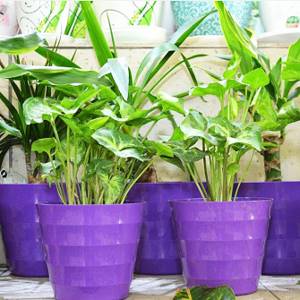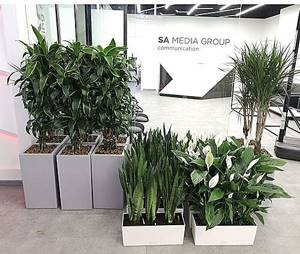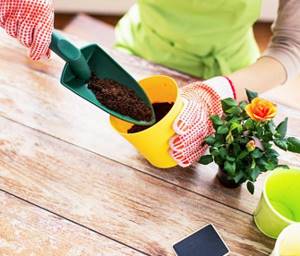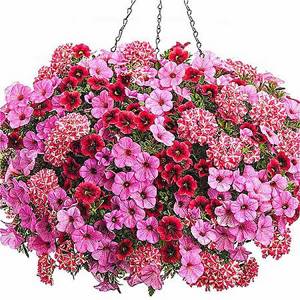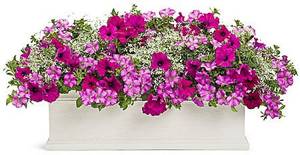When can you replant indoor flowers?
It is best to do this procedure with the arrival of spring. The choice of month - March, April or May - depends on a number of factors. In spring, flowers usually begin to grow faster and need fresh soil and fertilizer.
Flowers in flowerpots sometimes require replanting
It is better to replant after flowering or long before it begins, during the dormant period. If buds appear, the procedure should be postponed until next spring. January, February, like any winter month, are not suitable for this.
It is recommended to replant perennial flowers at least once every 2 years. If they grow very slowly, then replanting should be done once a year. Cacti can live freely in the same soil for more than 5 years.
Advice! You can follow the lunar calendar to know when to replant indoor flowers; the most favorable day is selected according to it.
It is better to buy a calendar for the year to know which days are the most favorable. It is believed that replanting indoor plants during the full moon is not a good idea. Replanting home flowers is usually done during the waxing moon or when the moon is in fertile signs - Pisces, Taurus, Cancer.
How to replant indoor flowers at home when replanting is required
As any plant grows, the volume and its root system increase. It is important to take the latter into account and replant the flower into a new container from time to time, otherwise there is a danger that growth will slow down.
A direct signal for replanting is the growth of roots through the drainage holes. In this case, a transplant is simply necessary.
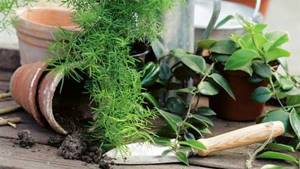
In addition, transplantation is recommended when:
- The green pet is affected by pests or diseases;
- Lack of micro- and macronutrients.
When replanting, it is important to take into account not only the condition of the green pet, but also the time of year and the individual properties of the variety. So it is better to replant in the spring, during the period of active growth, but before the formation of buds.
In addition, it is worth considering such features as:
- Refers to annuals or perennials. The latter are recommended to be replanted no more than once a year or even several times. Succulents can easily grow in one container for up to six years;
- Before transplanting, it is important to familiarize yourself with the lunar calendar: it is not recommended to do it during the full moon, but the waxing moon has a beneficial effect on growth. Landings made on days when the moon is in the signs of Cancer, Taurus or Pisces give especially good results.
Before starting the transplant, it is necessary to prepare a new container, which should exceed the previous one in diameter by no more than a few centimeters.
Before planting directly, the pot must be scalded with boiling water, after which:
- Place a drainage layer of expanded clay or fine gravel at its bottom;
- Pour a substrate over the drainage, which must meet the plant’s needs for nutrients and acidity level. The soil must allow air and moisture to pass through.
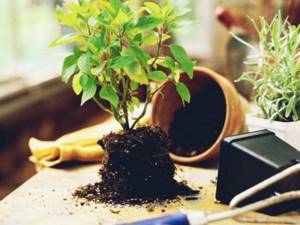
You can determine whether it is necessary to transplant it into a new container as its root grows. When moving to a new habitat, it is important to follow some rules, otherwise the flower may suffer.
You can learn more about replanting indoor plants by watching the video:
Emergency transplant
An emergency procedure is performed if the flower is in a very neglected state:
- overwatered and the roots rot;
- leaves begin to fade and turn yellow;
- there are pests;
- the roots do not have enough space in the pot;
- the flower no longer grows.
When can flowers be replanted in this case? At any time. After all, the risk that the bush will die from overwatering or from pests is higher than the time of year outside the window.
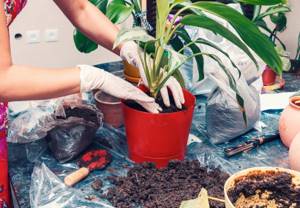
The flower is transplanted into a larger pot as it grows
Sometimes mechanical factors also occur, for example, a flowerpot may fall and break. In this case, the flower is immediately moved to a new pot.
Important! Replanting should only be done if the tree really needs it. But you shouldn’t just change the soil and pot - this causes the plants to experience a lot of stress.
Replanting indoor plants: general rules
People are so amazingly created that we are always attracted to living nature. You rarely see a house where the window sills are empty; more often there are pots of flowers on them, pleasing the eye with rich greenery. To ensure that this always happens, housewives pay a lot of attention and care to their garden on the windowsill.
We, residents of Russia, have been in captivity for almost six months in our apartments and houses, surrounded by gray gloomy days and lifeless snow cover. In order not to plunge into the world of deep depression, we surround ourselves with evergreen indoor plants. They give us the illusion of the presence of delicate spring greenery and a riot of summer colors when they bloom.
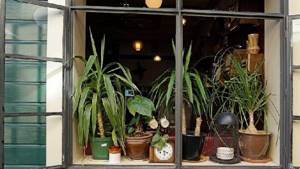
Since we are talking about living plants, over time each indoor flower requires replanting. The first reason is that the plant increases in volume, the roots become crowded, and they crawl out of the pot into the drainage hole.
Second: the nutrients have been sucked out of the soil, and fertilizing no longer helps the plant feel good. The leaves begin to turn yellow, even young ones, and fall off. As soon as you water it, you look, and the soil is already dry, this tells us that it’s time to change the pot and soil.
When is the best time to replant indoor plants? Like all living nature, flowers also have growth phases and resting phases. At the end of winter - beginning of spring, they enter the phase of active vegetation, or, in simple terms, they wake up. It is during this period that it is best to replant indoor flowers.
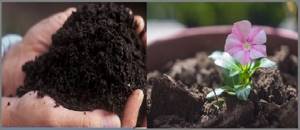
If we were unable to do this during the period March - April, then the plant will become more active and enter the flowering phase. At this moment it is better not to touch it and wait until the last bud fades. In this case, it is better to wait a year, because from October to February the flower is in the dormant phase, and replanting can destroy it.
We are now talking about a planned transplant, we will do it in 3-4 years, provided that the flower feels comfortable and its appearance is luxurious. If we observe something from the above, then we carry out the transplant a year earlier.
We replant the store-bought plant after a month of acclimatization in our apartment. During this period, we prepare the pot, soil, drainage, and from the transport container and substrate we transplant the flower to a permanent place.
Instructions for replanting plants
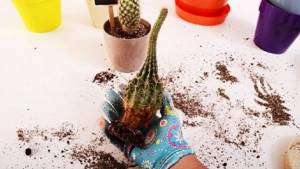
We start by selecting a pot into which we will transplant our plant. Its size should be slightly larger than the size in which it grew this year. We rinse the new pot with water, and if we use a previously used one, we clean it with a brush and wash it with soapy water.
Next, we take care of drainage and soil. We buy soil for indoor plants or specifically for a given flower. If there are a variety of flowers on our windowsills, then it is better to take a universal soil. Since it is suitable for any home flower and contains the necessary nutrients.
In fact, we will be engaged in transshipment. It differs from replanting in that during transshipment the plant is planted in a new pot along with the piece of soil in which it grew in the previous container. This is the least painful way for the flower.
There is no need to feed the plant during transplantation. Fresh soil has everything you need for growth and well-being. After three months, you can think about feeding; for this, we buy fertilizers in a specialized store and, according to the recommendations, feed them.
Don’t forget to put a layer of expanded clay on the bottom of the pot for drainage. The height of the layer depends on the size of the container, on average 1-3 fingers. Before we repot the plant, we add a small amount of fresh soil to the new pot. We do not bury the plant; it should remain at the same height as in the previous container. Add soil to the sides of the flower and compact it.
A transplant is needed if you see that the roots are not doing well - they have rotted. In this case, we carefully shake off the soil and wash the root system, cutting off the diseased roots. After this, we plant the flower in new soil. In this case, he will be sick, but there is hope that he will not die.
How to water home flowers
After the plant has settled in its new “apartment”, it needs to be watered. During transplantation and transshipment, water it abundantly until excess water flows out of the drainage hole.
This is necessary to ensure that all air cavities that were formed during the addition of soil disappear. Then the roots will have close contact with the ground, all nutrients will be available. Pour out excess water from the pan.
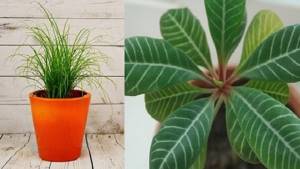
Transplanting is stressful for a plant, so at first it will slowly absorb nutrients and water. We visually monitor the condition of the soil and water the flowers only when the soil is dry, otherwise there is a chance that the roots will rot.
In the future, when watering, we follow the regime that is necessary for this plant. Some people need watering often, while others, like a cactus, need watering once a month. The frequency of watering also depends on the time of year. In winter, when the flower is at rest, you need to water it less often than in spring and summer.
A properly transplanted indoor flower quickly adapts to new conditions. Now your flower will be comfortable in a new spacious container, and it will delight you with emerald greenery and abundant flowering.
How to properly replant home flowers using the transshipment method
Transshipment is used when the roots have entwined all the free space in the soil. Many plants have very fragile roots. Such a plant needs to be watered in advance, then walk along the edge of the ground with a sharp knife, and carefully holding it with two fingers, remove it from the pot onto the palm of your hand with soil and roots.
Important! There is no need to shake the soil, as this will damage the roots. The plant will take a long time to recover and there will be no improvement after replanting.
Next, you need to carefully transfer the bush into a prepared pot filled with drainage. A plant placed in the center with an old lump of earth is covered with fresh soil in a circle, filling the space between the walls of the pot, and then lightly compacted.
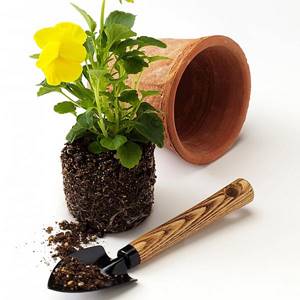
The plant is removed from the pot along with a lump of earth
Garden tools for replanting
Before starting the procedure, you should prepare everything you need: a pot, drainage, soil, a sharp knife, coal, a garden trowel.
Replanting indoor flowers
The procedure is carried out in two ways - transplantation or transshipment, in which the earthen lump is not disturbed.
Transshipment
The transshipment method is used for the following plants:
- suffering from the destruction of the earthen coma;
- young, intensively developing;
- adults, large, negatively reacting to root damage.
Recommendations on how to replant plants using the transshipment method are that the ball of soil around the roots is not disturbed. The plant is taken out of the pot, transferred to another, placed at the desired level, adding fresh substrate on top of the drainage and on the sides. If such an operation is carried out in autumn or winter, when the plants are dormant, the harm from it will be minimal.
Transfer
The flower is carefully removed from the container. If it is small, the palm is placed on the surface of the soil, with the stems of the plant placed between the fingers. With the other hand, turn the container upside down and lightly tap on its surface to make it easier to remove the flower. Thanks to such measures, he, along with a clod of earth, will end up in the palm of his hand. If the indoor flower feels quite well, you can change not the entire substrate, but only part of it.
The roots with a lump of earth are placed in a bag to protect them from drying out. The pot is freed from drainage and washed. Return the drainage to its place and pour some fresh soil on top of it. The top layer is removed from the earthen clod until the outer roots are exposed. Carefully place the plant in the pot, carefully adding new substrate from the sides and top, while lightly compacting it. The earth is watered.
How to properly replant indoor plants with a complete replacement of the substrate?
First, they are taken out of the pot, the roots are freed from the soil and examined. Sick and damaged ones are carefully trimmed and the sections are sprinkled with charcoal powder. To maintain balance between the underground and above-ground parts, green shoots are also pruned.
A drainage layer of approximately 2–3 cm is placed at the bottom of the pot. For flowers that cannot tolerate excess moisture, drainage can occupy up to a third of the volume of the pot. Fresh soil is poured on top in a “mound”, the plant is placed on it, the roots are evenly distributed down the side surfaces of the soil. Holding the stem with one hand, pour the earth with the other.
It is necessary to calculate so that the upper roots are covered with 2 cm of soil. Flowers are watered, except for some types of cacti and specimens with rotten roots. The substrate should be slightly moist, so you can water the cacti after a few days. For ease of watering, pots are always filled with soil not to the brim, but 1–1.5 cm below the edge.
Any replanting causes concern, so after replanting, the indoor plant should be placed in a greenhouse for 4-5 days - a shaded, warm place. There are light-loving specimens that require a fairly bright place, but at the same time direct exposure to the sun's rays is excluded. To the question whether it is possible to replant flowering plants, the answer is negative. After such stress, they take a long time to recover.
The process of properly replanting a plant
First of all, you should know what type of flower it is. This will help you decide on the size of the pot, because each plant has its own preferences. Some people love a free planter, while others prefer to live in close quarters.
Typically, plants that are cramped are transplanted into a larger pot. It is impossible to move from a small container immediately to a larger one, as the plant may die or simply not take root. The bush or tree must be watered first to make it easier to remove it from the pot, and if necessary, shake off the poor soil.
Advice! It is better to buy soil in a store, as it contains all the nutrients and necessary substances.
The replanting process is an excellent opportunity to assess the condition of the roots. If there are dried and damaged roots, they should be cut off and the cut area should be treated with charcoal or a solution of potassium permanganate.
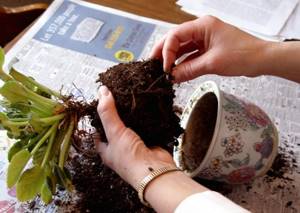
It is better to remove dried and damaged roots
The landing procedure looks like this:
- Drainage about 2 cm thick is placed at the bottom of the pot.
- Place the plant in the pot in the center.
- The free space is filled with fresh soil, lightly compacted.
The soil is compacted because it usually settles after watering. Often, after replanting, a little more soil is added to the pot.
HOW TO ORDER A SERVICE: FLOWER TRANSPLANTING/PLANTING?
| 4 solutions: | |||
| Call our managers at the number and immediately order a florist to transplant plants: +7 – 915 – 306 – 95 -48 from 8.00 to 20.00 daily | Send a photo of your flowers to WhatsApp so we can quickly calculate the cost of planting. WhatsApp: +7 – 915 – 306 – 95 -48 | Send photos of flowers and their quantity by email - we will prepare a commercial offer and an estimate for replanting flowers in the office. Email: [email protected] | Leave a request in the feedback form - write your phone number and email - we will contact you to calculate the plant transplantation and agree on the day the specialists will come to you LEAVE A REQUEST |
Have you bought or ordered plants? Are you not a professional florist and don’t know how to replant flowers? Are you aware of the difficulties of replanting, realizing that you can damage the roots of flowers or compact the soil incorrectly, which will lead to slower growth or drying out of plants? What if the plants you ordered for the office are expensive?
Why should you calculate and purchase soil and drainage yourself, try to plant or replant flowers yourself correctly, not knowing whether they will survive after an unprofessional transplant, when you can call florists to the office who will quickly and accurately plant the plants.
Help from a florist in replanting flowers
|
|
Replanting flowers - how much does it cost?
|
|
The photo above shows one of our work on replanting more than 50 plants at SA MEDIA GROUP - BEFORE and AFTER.
The cost of replanting flowers in pots depends on the size of the plants and their appearance. Small flowers - replanting from 100 rubles. per piece, large sizes from 170 cm – 1000 rub. Cleaning of plants and pots after replanting is included in the cost of the work. Prickly plants and plants with a wide crown are calculated individually based on their size. The location of the object is also taken into account - Moscow or outside the Moscow Ring Road.
Why should you trust our specialists to transplant flowers?
|
|
When is flower transplantation needed?
|
Landing of flyers on the sites of restaurants, cafes, verandas
|
|
|
Dear Clients ! We do outdoor landscaping for cafes, restaurants, patios, bars:
- Design and planting of flower beds and flower beds;
- Planting summer flowers in flower pots and floor boxes;
- Landscaping of summer cafes - terraces, verandas with summer flowers.

#transplanting flowers #
How to check the need for a transplant
To check whether the plant needs a new pot or soil, you need to carefully remove it along with a lump of earth. If it holds firmly, you need to slightly moisten the soil.
If the entire soil is shrouded in roots that are desperately trying to penetrate through the holes in the pot, then there is definitely not enough space for them, and it is necessary to urgently relocate the flower. If there is still free space in the container for roots to grow, then it is better to hold off on replanting for now.
It also happens that a plant stands in one place for a long time - does not grow, does not bloom, does not produce buds or new shoots. In this case, it makes sense to have an urgent transplant.
Selection of drainage and soil mixture
It is recommended to lay drainage in a layer of 3-4 cm at the bottom of the container. The following is used as drainage:
Sometimes spruce needles and bark are used as drainage. In some cases, a large layer of drainage is required - almost 1/3 of the pot.
But in any case, the soil must always meet the following requirements:
- be nutritious;
- let air into the roots;
- contain acidity for certain species;
- free from pests;
- do not retain moisture.
Which pot to choose
Today, two types of flowerpots are popular - plastic and ceramic. Each of them has its own set of advantages and disadvantages, but in any case, the plants feel good and grow in both types. There is, of course, one big difference - the price.
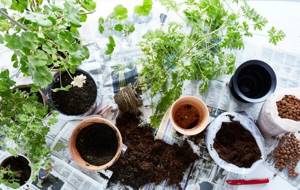
Ceramic and plastic pots have their pros and cons
Ceramic pots are a little more expensive and may not be affordable, especially for those who have a lot of indoor plants. Many people prefer to have all the pots in the same color scheme and the same shape, so that not only the flower, but also the flowerpot blends beautifully with the interior.
Plastic
Plastic containers are inexpensive, lightweight, transportable, and come in different shapes and colors to suit every taste.
But at the same time, their shortcomings include their fragility and instability. If the plant is large, it can easily tip over. Moisture does not evaporate well through plastic walls, which can cause root rot.
Ceramics
Ceramic containers are expensive, but they also come in different shapes and colors. They are resilient. They keep the plant warm in winter and cool in summer. Moisture evaporates well through the ceramic walls.
Disadvantages include weight and salt deposits on the walls. If the flowerpot is covered with glaze, it will not allow air to pass through well.
Important! Before choosing a pot, all the pros and cons are weighed. But the main thing in all this is proper care of the plant.
Carrying out cosmetic surgeries
Surgery, although cosmetic, is still a risky activity. Which of them can and cannot be done during menstruation? For example, cosmetologists still do not recommend doing such a well-known procedure as mesotherapy.
Mesotherapy
Mesotherapy involves the introduction of a special cocktail of nutrients and other substances under the skin. Cosmetologists advise to refrain from this operation during menstruation. Mesotherapy may not produce results and may be painful.
Botox
Botox injections are now offered by many beauty salons. With their help, wrinkles will be smoothed out and new ones will not appear. But is it worth injecting Botox during your period?

Botox injections are best done after your period ends.
Cosmetologists are against the use of Botox at this time, because, in addition to the painfulness of the procedure, there is a possibility of any side effects at the sites of Botox injections, such as bruises or hematomas. Therefore, reschedule the Botox injection procedure for another period. But at the same time, there are no medical contraindications for Botox during menstrual periods.
Peeling
The cosmetic procedure, peeling, has many varieties. And if you want to do facial peeling and get good results, then refrain from doing it during your menstrual period.

It is better to avoid cleansing your face during your period.
Although you can carry out light peeling these days. But remember that the condition of the skin deteriorates somewhat during menstruation, and therefore do not rush to correct it with peeling, wait a few days.
Shellac
Shellac is a gel polish that has a durable and durable coating. Shellac can be applied in a salon, or you can do it yourself. And since a wide variety of signs are associated with menstrual periods for women, a kind of myth has appeared that shellac should not be done during this period. The myth has absolutely no basis, so feel free to apply shellac during your period.

A beautiful gel polish applied during critical days will brighten up this period.
Further care
How to replant indoor flowers at home is already clear. But it is equally important to provide them with proper care after a change of location.
In this case, the following rules must be observed:
- Immediately after the procedure, you should not place the pot on a window exposed to open sunlight. It is better to place it in a slightly dark place for five days.
- It is also not worth watering right away so that the roots, in search of moisture, take root in the new soil.
- It is not recommended to fertilize flowers immediately; it is better to do this a month or two after transplantation.
- You need to spray the leaves every week. But there are also those that do not require spraying.
What will quarantine be like in Russia in the fall of 2020?
If the decision to introduce restrictions is made in the regions of the country, then, most likely, quarantine will be introduced gradually, as in the spring of 2020, during the first wave of the coronavirus epidemic.
The self-isolation regime primarily affected older citizens and people with chronic diseases, who constitute the main risk group during the period of increasing number of patients. In the fall of 2020, doctors and teachers will also be at risk, as they cannot avoid contact with potentially infected people. Other representatives of the public sector will also be at risk.
Vaccination, which will begin earlier than usual in Russian regions, can save the country from repeating the spring scenario. Already in September 2020, citizens are encouraged to get vaccinated against the flu, and in October, the mass production of the coronavirus vaccine is expected to begin. Despite the threat of an epidemic, vaccination will be carried out voluntarily and disease prevention will become the responsibility of each individual member of society.
Source
What to do if replanting a plant is impossible
It happens that replanting is impossible because the plant is very large. But still, the soil in such a pot needs to be periodically changed, as far as possible, with fresh soil rich in various microelements. If this is not done, the plant will begin to wither, as the earth will be depleted, and all living things will simply die.
It is impossible to remove all the old soil, but in such cases it is worth changing only the top layer. This procedure is recommended to be done every year or two. It is better to do this in spring and autumn, since a large plant requires nutrients and fertilizer more than others.
Each plant needs careful care: watering, fertilizing, pruning and replanting. Caring for indoor flowers is not difficult, the main thing is to remember some rules and follow them.
When to replant flowers
To figure out when to replant indoor flowers, you need to know their development cycle. Most plants have a dormant phase when they cannot be disturbed. More often this period occurs in the winter months, so it is better to replant in March or April . If such a moment is missed, then the procedure can be carried out later (until the end of September).
By time of day, you need to focus on morning (before 10 o’clock) or evening (from 16 to 20 o’clock). It is especially important to take this rule into account in summer, when active sun during the day worsens adaptation after transplantation.
How to check the need for a transplant
The need for regular transshipment is explained by the fact that most representatives of the flora in cramped conditions are susceptible to diseases, stop growing, blooming or lose foliage . The reason for this is the increasing need for nutrients and moisture with simultaneous depletion of the soil.
You can notice a number of external signs, when they appear, the need for a transplant becomes obvious:
- Filling the entire volume of the pot with roots and even looking through the drainage holes at the bottom.
Tip: to check this parameter, you need to dig a small hole at the very edge of the pot. If the roots are visible, then replanting is required.
- Rapid drying of the soil after watering. This means that the plant does not have enough substrate to absorb the required amount of moisture.
- Slowing down the growth rate of the plant, subject to maintenance conditions and regular fertilizing.
- Yellowing and shedding of both young and old leaves. If such a sign is the only one, then the appearance of diseases and pests should be excluded.
- White coating on the inside of the walls of the pot due to an excess of salts and oxidation of the soil. The green color on the soil surface also indicates an imbalance of microelements.
- The previous transplant took place more than 3 years ago.
Process description
A method of replanting that is gentle on the roots is transshipment together with a lump of earth. Here's a detailed plan on how to do it correctly:
- Expanded clay 2 cm thick is poured onto the bottom of the new flowerpot.
- Add new soil (also 2 cm).
- Use a garden spatula or knife to carefully separate the soil from the edges of the old pot.
- Next you need to remove the plant. For small sizes, it is enough to turn the pot over, holding the flower by the base. If the dimensions are large, you can pull the trunk up or put the pot on its side, tap the walls with your palms and remove the pot from the roots.
- Place the flower with a lump of earth in the center of the new pot.
- Fill the free space with fertile substrate, compacting it lightly. It is important to check the stability of the plant in a new position.
- Sprinkle a 1–2 cm layer of soil on top.
- Water from a watering can, and if the shrinkage is severe, add more soil.
Proper transplantation of indoor flowers: which pot to choose
The first thing that is important to consider when choosing a container is size. You should not radically replace a tiny pot with a huge analogue of a bucket; the difference between the previous and next pot should not exceed four centimeters.
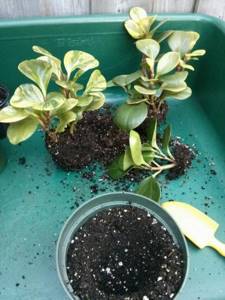
When choosing, it is recommended not to forget that drainage is important for any specimen, so pots without holes in the bottom will not be suitable. When water stagnates, the roots rot, which leads to the death of the entire plant.
Clay is considered the most optimal pot material - it is an environmentally friendly material with a porous structure that is most suitable for your beloved green pet. However, nowadays most people prefer plastic.
It is convenient, durable and inexpensive; if necessary, such containers are easy to deform and even cut.
When choosing a new home for your green pet, it is recommended to pay special attention to several details: the size and presence of drainage holes.
These two factors must necessarily meet the requirements.
What to do before transplant
Before transplanting, you need to buy everything you need in advance. When choosing a pot, you should correctly determine the required dimensions. It should be no more than 5 cm larger in height and width than the previous one.
If a new pot is purchased for replanting, it is washed from the inside with plain water. Before the procedure, old flowerpots must be thoroughly washed of the previous soil . This will prevent the development of pathogens that may have remained in the used pot.
It is better to soak clay or ceramic containers for a day in a soapy solution, then wash the inside with a brush.
Before transplanting, fertile soil is purchased or prepared in accordance with the type of plant. Stores sell ready-made substrates for most varieties of indoor flowers, balanced in composition and acid-base balance.
The mixture you prepare yourself will have to be disinfected, especially if one of the components is garden soil. The substrate must be poured with a hot solution of potassium permanganate, or it can be kept in the oven at 70 ° C for 30 minutes.
When not to transplant
The unsuitable time for transshipment is from October to March. During this period, all life processes in the plant are slowed down, and the ability to absorb microelements from the soil is lost. If transplanted, the roots may rot, and there is a high risk of ruining the flower.
The exception is those types of indoor flora in which the active growth phase occurs in winter. For them, the optimal timing of transplantation is opposite to the generally accepted ones.
A flower just bought in a store needs to replace the substrate, but it is better to let the plant adapt to the new microclimate for 1-2 weeks and then replant.
It is also recommended to postpone replanting if flowering begins soon, when buds begin to appear on most plants in June. You should not disturb your household during the flowering period.
This will lead to wilting and premature dropping of the corollas. It is recommended to change the pot 2-3 weeks after the last flower falls .
For some diseases, it’s worth considering whether you can replant the flower now or wait:
- Yellowing of foliage and rotting of roots can be eliminated by returning the conditions to normal. Optimal soil moisture, changing the lighting regime and eliminating drafts can restore the plant's decorative appearance, while unreasonable replanting, on the contrary, can lead to the death of a weakened flower.
- Lethargic foliage and lack of flowering may be a result of lack of moisture or excess sunlight. To correct the situation, it is enough to adjust these parameters.
- The appearance of pests is also often manifested by falling and yellowing of foliage. At the same time, you can notice foreign deposits or insects themselves on them. For treatment, the plant is treated with an insecticide.
Energy imbalance
During menstruation, a kind of cleansing of the body occurs. Not only the unnecessary egg that was not fertilized goes away, but also all the negative energy that the woman has accumulated over the month. This is why many feel broken, empty and powerless.
There are many old beliefs about what women should not do during their period, for example:
- to bake bread;
- ferment cabbage;
- plant a vegetable garden;
- weave;
- swim in ponds;
- and even approach a house that is being built.

Swimming in water bodies is prohibited during menstruation
What are these rules connected to? Is it really true that during this period women should literally be bypassed and they themselves should not take on anything? This is most likely explained by the fact that during this period a woman’s energy is especially powerful and, at the same time, most often negative. After all, the body gets rid of everything unnecessary, everything bad, and is renewed. And all of the listed actions are capable of absorbing this energy into themselves, and our ancestors did not want this.
But if many of these rules are not relevant today, then there are some that modern women should know. Namely, what is quite possible to do during menstruation, and what is better to refuse and why it is better to do it.
Basic mistakes
The flower is transplanted immediately into a pot that is too large. After the procedure, the plant is often watered or fertilized. This makes adaptation difficult, since under stress the roots slowly absorb moisture and minerals.
The speed of subsequent recovery depends on which moon the transplant was performed on. Therefore, performing the procedure in the decreasing phase is also considered an error.
Sunburn on the leaves is possible even from the usual lighting conditions, so it is recommended to remove the flower to partial shade after replanting.
How to properly replant indoor flowers in pots
06/22/2019, 09:00 EST
How to properly replant indoor flowers in pots, what is required for this - every gardener needs to know this. The requirements for growing conditions for flowers propagated and grown at home are not as complex as for exotic ones bought in a store. Each indoor plant needs to be replanted at a certain period of growth. There are basic rules for carrying out such work.
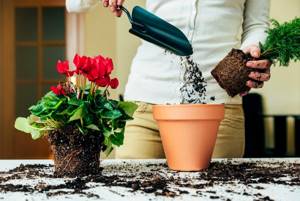
Photo: Depositphotos
Time and rules for replanting indoor plants
In spring, all plants wake up and begin to develop, writes Prelest.com. It's time to replant indoor plants. Store-bought flowers can be replanted a month after purchase, or this work can be done in a few months. Home-adapted young plants are replanted every year (preferably in the spring), three-year-old plants - after two to three years.
Potting soil can be replaced:
- partially - the top soil layer 4-5 centimeters deep is removed;
- partially with plant transshipment;
- fully.
Partial replacement of soil is carried out every six months, this is especially necessary in containers with large plants. The top layer is carefully removed without damaging the thin surface roots of the flower, and topped up with new soil of suitable composition. The surface is watered with settled water at room temperature.
The safest and most root-friendly method is transshipment. The capricious flower requires replanting in this way. At any time of the year, plants waddle over, their roots peeking out of the soil or from drainage holes. The earthen lump dries out a little, the pot is slightly crushed, the lump with roots is stretched out and rolled into a new pot 2 centimeters wider than the previous one. New soil is added to the edges of the root ball, compacted, and watered.
Complete soil replacement is done when nutrients are depleted. Many people doubt whether it is worth touching the rhizome when replanting. Definitely worth it. To do this, the plant is completely removed from the pot, washed, and the roots are examined. Damaged, dried out, diseased root threads are removed. The container is selected to be 3-5 centimeters larger than the previous pot. The soil mixture should be matched in composition to the type of flower.
Replanting purchased plants
There are subtleties to replanting purchased plants. Before sale, the land is saturated with nutrients for lush growth and flowering. There is enough food for several months, so there is no need to rush to transshipment to a new land. It is worth finding and reading everything about the purchased flower, its nutritional needs, soil composition, and amount of watering.
During the first month, the new plant must adapt to the conditions of its new home. If the flower was purchased at a sale, you need to inspect the root system. To do this, carefully remove it from the pot and inspect the visible part of the root system. If there are damaged roots, remove them and treat the removal areas with charcoal (powder) or other protective agents.
The plant is placed back into a pot or container with a wider volume, and nutritious soil is added. The soil can be prepared at home or a ready-made soil mixture can be purchased at the store. After transplanting, water the flower and place it in a transparent bag or cover it with a transparent packaging cap from the cake.
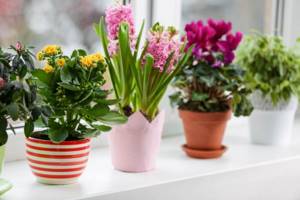
Photo: Depositphotos
Selection of dishes and soil for replanting indoor plants
After adaptation, some plants grow their root system very quickly; another replanting will be required. The condition for this is the roots peeking out in the drainage holes of the pot. Without replenishment with new soil, the flower will suffer from a lack of nutrients, which will affect its appearance. This does not apply to epiphytic plants, which do not require nutrients from the soil.
Selection of pot
The pot is selected according to size and volume. The material from which the container is made is taken into account. Its size is chosen wider and deeper by 4-5 centimeters. To calculate the volume of the required pot, you can add 10% to the previous one when replanting.
Plastic pots are lightweight; small plants can be transplanted into them, as well as young shoots for propagation. Tall plants should be replanted in clay or ceramic containers that are heavy and stable. Clay and ceramic pots need to be washed well, doused with boiling water, and soaked overnight.
Soil mixture composition
The soil is selected according to its composition for each plant; it must be sufficiently loose and nutritious. You can buy a ready-made mixture in a specialized store, or you can prepare it at home. The main components are soil, sand, peat, and nutritional components. For the base, turf, leaf, coniferous or soil from a compost heap is used.
Turf soil is taken in the spring from areas where wild grasses or legumes grow. To do this, remove a ball of turf 10 centimeters thick with a shovel and cut it into cubes. The cubes are folded with grass inside, into a container or wrapped in film. During the year, the soil needs to be turned over at least once and covered for the winter. It can be used next spring.
For leafy soil, you need to go to the forest or forest belt where linden, maple, and acacia grow. You should not take soil from under an oak or chestnut tree; it contains many substances that are unsuitable for replanting indoor plants. You can prepare leaf soil yourself if you have your own plot of land. Fallen leaves are collected in a heap and protected from drying out.
The layer thickness should be 1-1.5 meters, mixed with pieces of bark and thin branches. During the year, the pile needs to be turned over several times to ensure uniformity, and covered for the winter. After a year it is suitable for use.
Coniferous soil is collected under trees along with pieces of bark and twigs. It is mixed throughout the year and sheltered for the winter. It is used for flowers that love soil with a high acidity level. Soil similar in use is collected in the heather germination zone.
Only well-rotted soil is taken from a home compost heap, a year or two after the heap was laid. This valuable organic fertilizer makes up a small part of the components of the replanting soil.
To replant indoor plants, you need to create a certain soil composition. This can be done at home by looking up the required dosage on websites.
Before planting or replanting a flower, the soil must be disinfected.
- To do this, you can use a container with small holes in the bottom. Place the soil in it and pour boiling water over it.
- If the soil is harvested in the summer, you can fry it in the bright sun under glass, covering it with black film.
- You can also use drugs that destroy bacteria and fungi and saturate the soil with beneficial microorganisms.
- The soil prepared in the fall is frozen in severe frosts, spread out in a thin layer on any surface.
- You can fry the soil in the oven, but it will lose some of its nutrients.
You should not use chemicals for disinfection; this method can harm not only the flowers, but also those living in the apartment.
To loosen the soil, roasted coarse-grained river sand, pieces of charcoal, polystyrene foam, and bark are added. In what proportions and how to correctly compose the components of the soil, you can read on the floriculture website.
Flower transplant
- Work begins with preparing the pot, soil, water for irrigation, drainage, and tools. Next, step by step, the plant is transplanted:
- The first step is preparing the pot. A clay or ceramic pot is soaked overnight before planting. The plastic is washed and dried.
- A 2-centimeter layer of drainage is poured onto the bottom of the container (expanded clay, brick, pieces of a broken pot).
- The plant is removed and the roots are inspected for damage or disease.
- The roots are carefully cleaned from the upper earthen clod. Eating is required, the roots are shortened. To do this, part of the root system is removed with pruners or scissors and treated with charcoal powder.
- Soil is poured into the pot, in a layer of 2 centimeters, and the roots of the flower are placed. The planting depth should be the same as before transplanting. All gaps are filled with moist soil.
- Knead the earth around the trunk with your fingers and add more sleep.
How to repot indoor plants
It is good if the pot has a drainage hole to drain excess water. Cover it with a piece of crock and pour a layer of drainage - it is 1-2 cm for small pots. If you have a pot without a drainage hole, simply add drainage to the bottom. Place a layer of new soil on top. Drainage along with the soil should occupy no more than a quarter of the height of the pot.
Remove the plant from the old pot. Grabbing it at the bottom so as not to tear it from the roots, move it a little from side to side - perhaps the plant can be removed in this way. If this fails, you can insert a spatula or wide knife between the layer of soil and the wall of the pot and help separate it. You can tilt the pot and gently hit it on the table surface. The point is that you need to pull out the plant along with the root system, trying not to damage it.
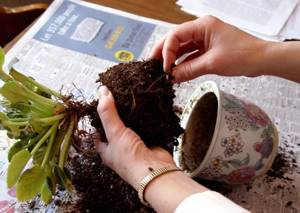
Carefully remove all old soil from the root system and carefully examine the roots of the plant. If there are dry, diseased, rotting ones, then cut them to the healthy part.
Place the plant ready for relocation vertically exactly in the middle of the new pot. Fill the pot with soil around the plant to the very top.
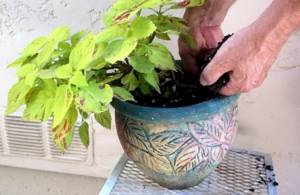
Compact the soil a little and immediately water the plant generously. There is no need to feed the plant immediately after transplantation; give it time to get used to the new pot. The first feeding should be no earlier than 2-3 weeks after transplantation. As a rule, replanting a plant stimulates its rapid growth.
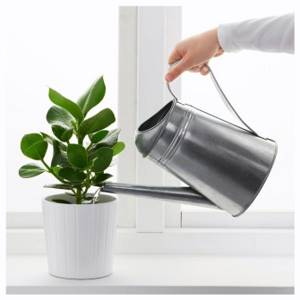
What to do with plants that you don't need to transplant into a larger pot?
For example, you are satisfied with the size the plant has reached and you want to stop there, but the soil is depleted and the plant needs to be replanted. Remove the plant from the pot as you would for a regular repot. Replace the soil in the pot with new one. Trim the root system a little with scissors - try to remove only thin new roots. Plant the plant in the same pot in which it grew before.
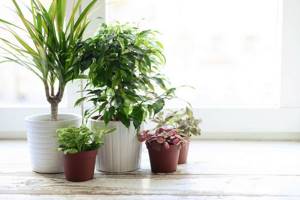
Some very large plants cannot be replanted due to their size. But they also need to change the soil to a new, more nutritious one. In this case, you can remove as much soil as possible from the pot, holding the plant, and add new soil. This procedure can be performed twice a year.
